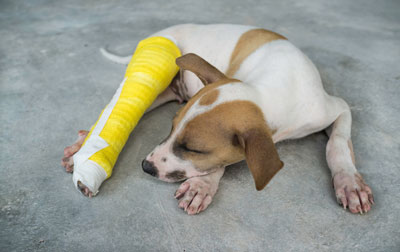First Aid for a Dog with a Broken Bone

If your dog ever suffers from a broken bone, he will be in a lot of pain. Here, you can learn some things you can do immediately to stabilize the situation until you can get your dog to a veterinarian.
Signs of Broken Bones in Dogs
If your dog breaks a bone, you may not always be aware of it. If you weren't with your dog when the injury occurred, you might see some or all of the following signs indicating a broken bone:
- Swelling of an area of the body
- Sudden pain
- Holding up a leg
- Leg held at an odd angle
- Bone poking through the skin or visible just below the skin
What to Do If Your Dog Breaks a Bone
Be aware that your dog will be in pain and feeling scared. Even a dog that is typically sweet and would never bite you may bite due to these circumstances. Be cautious when approaching a dog with a broken bone.
- First, restrain your pet by placing a muzzle on him and getting him leashed if he's large or wrapped in a large towel or blanket if he's small. You may be prepared with a muzzle in your canine first aid kit, or you may need to make a homemade muzzle.
- Don't touch the area that appears broken. If a bone is sticking out of the skin, do your best to stay away from that area.
- If your dog is small, carry him to the car and, ideally, hold him while someone else drives you to the veterinarian. Call ahead so the staff can be prepared for you.
- If your dog is large, enlist the help of another person and move your dog to a homemade stretcher to get him to the car. Ironing boards work well for this situation. You may also get your dog onto a large blanket and then, with another person, gently lift the four corners of the blanket, and carry him slowly and gently to the car.
To learn about other situations that occur in dogs and the aid you can render, check out: "First Aid for Dogs: An Overview."
You May Also Like These Articles:
Causes of Lameness in Dogs: An Overview
10 Ways You Could Be Shortening Your Dog's Life - Slideshow
Canine Epilepsy: Seizures in Dogs
Caring for Your Dog After You're Gone
Is It Safe to Sedate Your Dog for Travel?
Disclaimer: This website is not intended to replace professional consultation, diagnosis, or treatment by a licensed veterinarian. If you require any veterinary related advice, contact your veterinarian promptly. Information at DogHealth.com is exclusively of a general reference nature. Do not disregard veterinary advice or delay treatment as a result of accessing information at this site. Just Answer is an external service not affiliated with DogHealth.com.
Notice: Ask-a-Vet is an affiliated service for those who wish to speak with a veterinary professional about their pet's specific condition. Initially, a bot will ask questions to determine the general nature of your concern. Then, you will be transferred to a human. There is a charge for the service if you choose to connect to a veterinarian. Ask-a-Vet is not manned by the staff or owners of DogHealth.com, and the advice given should not delay or replace a visit to your veterinarian.


